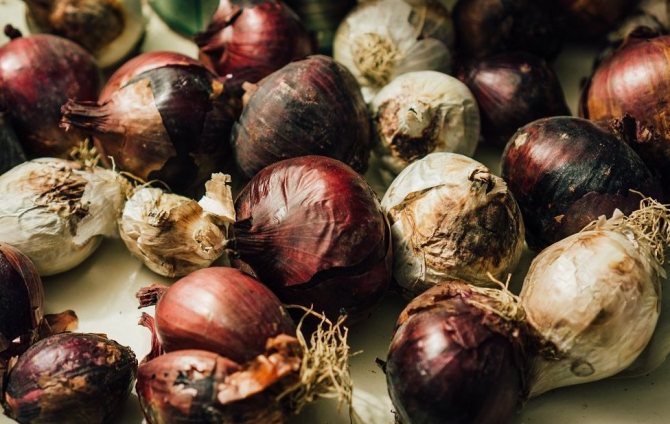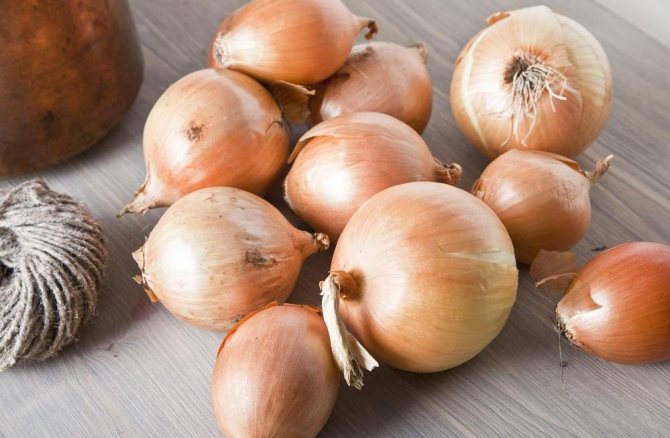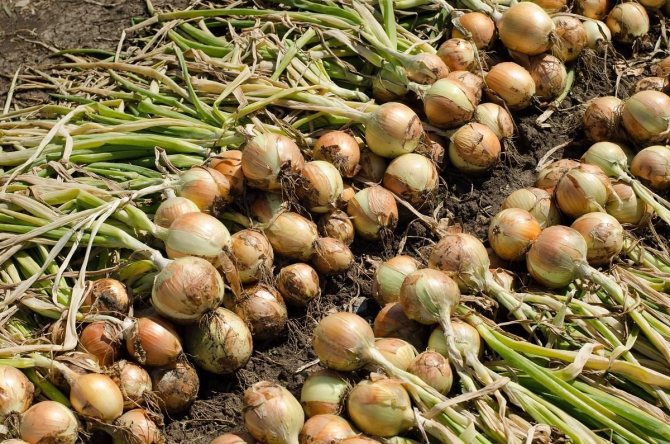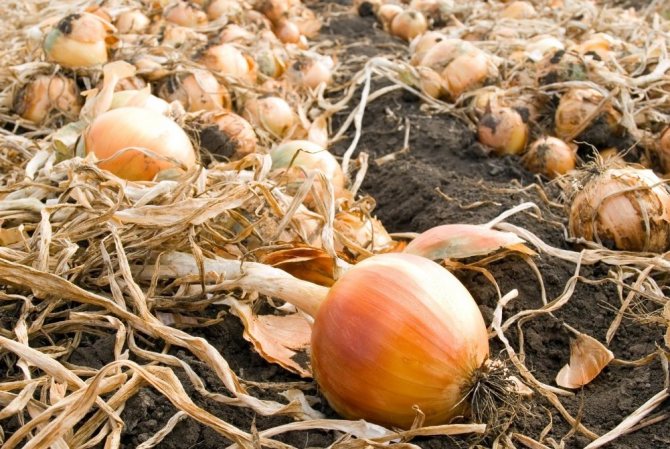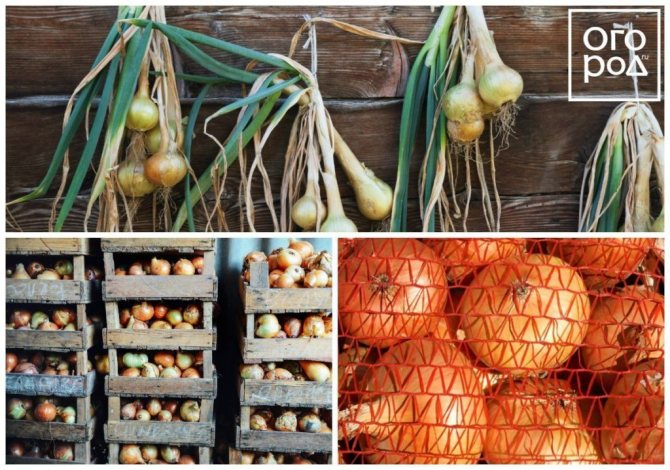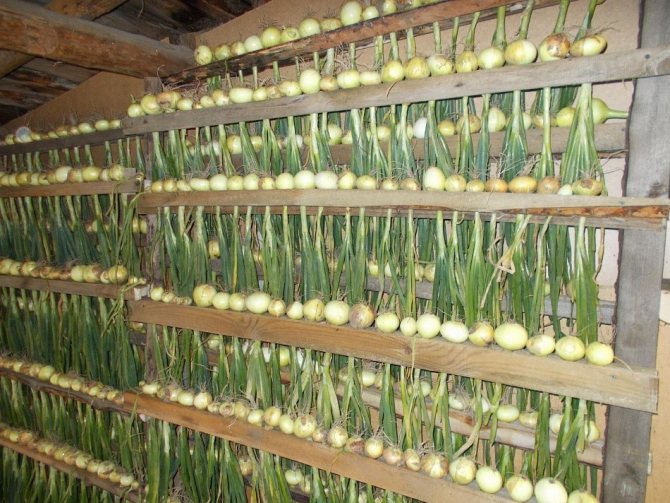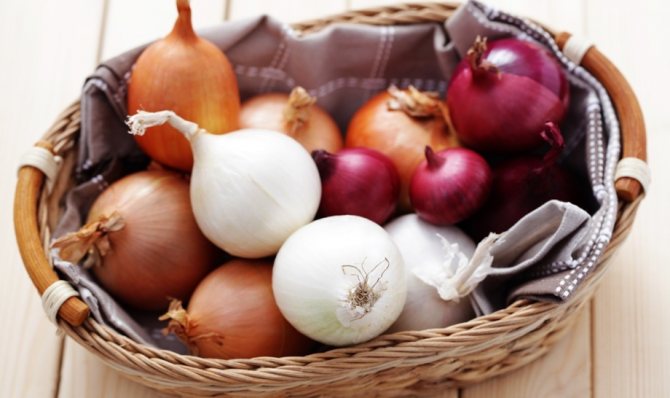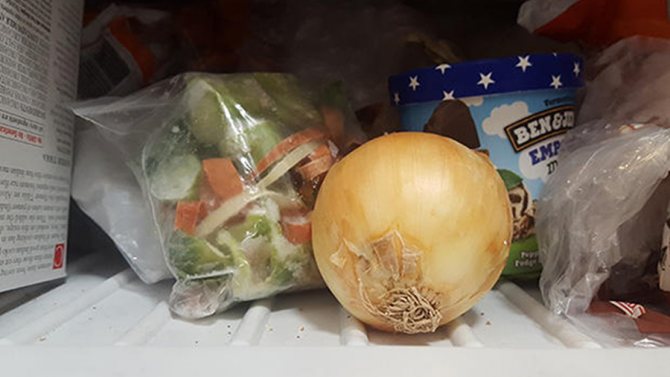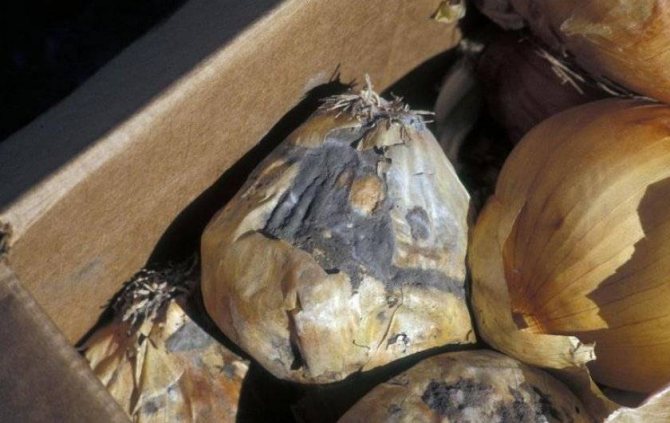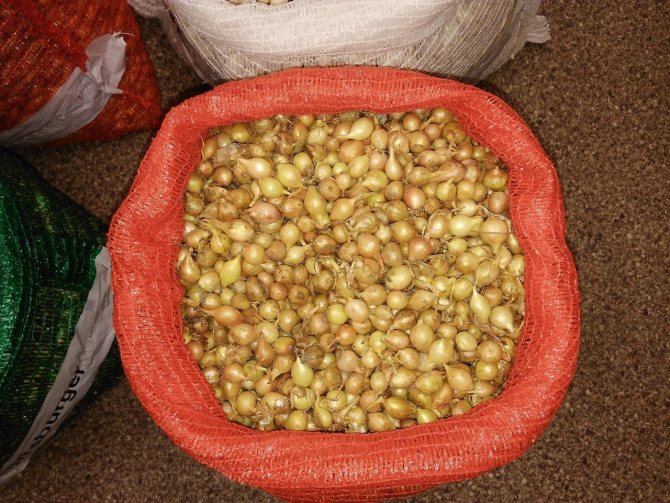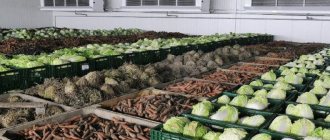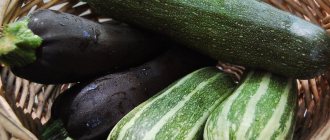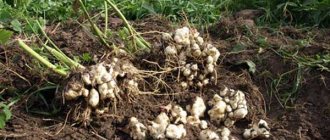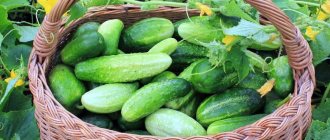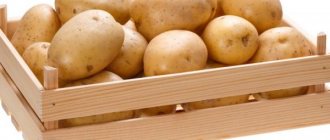When to harvest
How well the onion will be stored depends primarily on the right time for harvesting.
It is believed that the best time to dig onions is from early August to early September. Naturally, the exact time depends on the climatic conditions of the region and on whether the summer was dry or rainy. It is not difficult to determine whether a vegetable is ripe: its husk will easily come off the bulb, and the feathers will dry out and turn yellow.
Harvesting is necessary on a dry day so that the rain does not damage the plant. Try to select for long-term storage those specimens that do not have any damage, stains or traces of insects on their surface.

The vegetable must be ripe, otherwise it will quickly deteriorate during storage. An overripe plant should not be used for long storage: it begins to take root and new green shoots in a month or two, which means it will become unsuitable for cooking.
Experienced gardeners know that late-ripening varieties are best stored. And early and sweet ones, such as the Yalta variety, are not very suitable for laying in the winter.
You need to store the new crop in a dry and cool place, away from direct sunlight. If the humidity is too high, the bulbs will quickly rot.
You can also grow this plant for the next season using nigella - onion seeds. They are black, which is why they got this name. It is necessary to wait until the plant is fully ripe, and then cut off the inflorescences and leave them to dry. Arrows with seeds are best stored in a dry place, so they will easily separate.
Read more about how to breed onions in our article.
Storage preparation
In order for the onions to lie all winter and retain their freshness, the plant must be properly prepared before being placed in the storage area. This mainly consists of drying the bulbs. Any room with natural ventilation is ideal for these purposes - for example, a veranda or even a dry place in the shade outside. Often, the attic is used to dry the crop, where you can open a window and provide the necessary air circulation.
The bulbs should be spread out on the fabric in one layer so that they do not touch each other, and left for 7-10 days.
When choosing a place to dry, keep in mind that the sun should not fall on the onion. If you keep the crop outdoors, then bring it indoors at night so that it does not pick up moisture from the air and does not get caught in the unexpected night rain.
After the bulbs have dried, it is necessary to remove the remnants of the earth from them. This must be done manually, without using water. You should also cut off the roots and top, leaving a neck about 5 centimeters.
Attention! After putting the onion in storage, remember to periodically sort it out and make sure that it does not sprout.
Sort the crop carefully. For long-term storage, specimens with damage, soft ones, as well as those that still have green shoots are not suitable.
Do not leave onions without husks for a long bookmark: without them, they will quickly deteriorate, and should be used for food as soon as possible.
Why does onion rot during storage
If several bulbs disappear during the entire storage period, do not worry about this.This is a natural process, and even in industrial conditions it is impossible to achieve 100% preservation of vegetables. However, if onions began to rot en masse and at the same time not late in spring, when its shelf life has long expired, it is necessary to deal with the reasons for this phenomenon.
Onions can rot if they:
- laid for storage unripe and not dried;
- lies in a damp place;
- afflicted with disease;
- has mechanical damage;
- collected from the garden too late;
- does not belong to varieties suitable for long-term storage.
In the latter case, when growing onions for the winter, it is worth giving preference to spicy mid-ripening and late-ripening varieties that last longer than early, sweet and semi-sharp ones.
At what temperature to store in the cellar and apartment
Most often, onions are stored either in basements or in apartments.
- In the cellar
The optimum temperature for long-term storage of onions in the cellar is about 0 degrees Celsius for semi-sweet species and about -3 for more spicy ones.
The ideal moisture content for this type of vegetables is about 80%.
- In the apartment
If you decide to store onions in an apartment, then choose a room for it where the temperature will be about 20 degrees Celsius, and the humidity will be around 70%. Good ventilation is also important for the bow, otherwise it will “suffocate” and start to sweat. If the air in your home is too dry, cover the crop with the finished husk. If, on the contrary, the humidity is very high, you should add special absorbents to the containers with onions, which will absorb its excess. Usually sawdust or ash is used for these purposes.
Cold storage method
The method is based on placing the vegetable at a temperature of +3 to +5 degrees and an air humidity of 60-65%. Sevok can be placed:
- in a cold storage room or underground;
- bury in the ground in tightly sealed jars or put them in a cellar;
- small amounts of onions are stored in the vegetable section of the refrigerator.
Important! Before cold storage, onions are dried at a temperature of +25 .. + 30 degrees for several hours. Before planting, the planting material is kept warm for at least a week.
How much can you store
Under conditions where all storage recommendations are followed, onions can lie for about 6 months. Then it starts to sprout.


If you decide to chop the onion and freeze it in this form, then it can be in the freezer and not lose its taste and useful properties for up to six months.
Sweeter varieties of onions are stored for no more than 4-5 months.
Dried onions placed in a vacuum can stand for about a year.
Which onions are best stored in winter
Onion varieties are divided into spicy, semi-sharp and sweet. Sharp golden varieties are best preserved in the apartment - their shelf life is 6-8 months. Among the most popular spicy varieties are Nosovsky, Skvirsky, Zolotisty, Strigunovsky, Stuttgarter rizen, Centurion, Orion, Sturon, Arzamassky, Bessonovsky.


Peninsular varieties are stored for less time, for example, Donetsk golden, Lugansk, Karatalsky. Quite good keeping quality in red varieties - Bombay, Carmen, Red Baron. Of the semisweet varieties, Danilovsky, Krasnodarsky, Samarkandsky are preserved the longest. They can lie until February. The worst shelf life is in sweet varieties and hybrids, for example, Exhibichen, Sterling F1, Globo.
How to store
Secrets and tips for storing onions have been passed down from generation to generation. In this article, I have collected the most successful and reliable options for you.
Braids
If you plan to store your crop in braids, then after harvesting, do not cut the shoots: you will need them for weaving. Braids are convenient as they allow you to save space and hang the plant, providing it with perfect ventilation. In addition, the multi-colored bow braid is a real decoration of the country interior.
Wooden boxes
Boxes are great if you have a large crop of onions and don't want to waste time braiding them into separate braids. Drawers can be stacked on top of each other to save space and can be easily carried from place to place. Usually, wooden containers are used, which allow the crop in them to be well ventilated.
If you keep boxes on the balcony, then do not forget to monitor the temperature in winter: as soon as it drops below zero, it is better to bring the crop into the house.
Wicker baskets
If you need to have a few onions close at hand in your kitchen, you can place them in a small wicker basket. The vegetables will be provided with air circulation, and the husks from them will not scatter throughout the kitchen.
Carton boxes
If you don't have wooden boxes, you can use regular cardboard boxes instead. The principle of storage in them is the same, the main thing is not to forget to make holes in the walls for air circulation.
Nylon tights
This retro style of storage has a right to live today. The fact is that nylon tights have many holes that allow air to pass through. They are also easy to place and hang bulbs in. So if you have old tights, then instead of throwing them away, you can give them a second life and use them to store crops in a basement or garage.
Plastic mesh
Onions are often sold in special plastic nets. Take your time to throw them away - you can reuse them. Such packaging allows you to notice in time if a bulb begins to deteriorate, and also provides good air exchange.
It is better to store onions in nets during transportation or for a short time.
Packages
Plastic bags are not suitable for long-term storage of vegetables. The crop will quickly begin to rot in them due to lack of air. Only keep onions in this container if you are sure to use them for food within a few days.
Instructions for proper storage
Onion sets
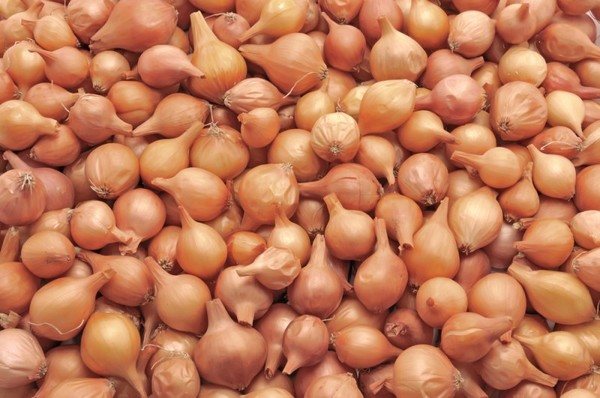

Onion sets have a bulb size of 1-3 cm in diameter
There is a way to grow onions in two years. In the first year, onion sets grow from seeds - these are small bulbs with a diameter of up to 3 cm. Onion turnips are grown from it the next year. Sevok is stored in two ways: warm and cold.
The warm method involves storage at a temperature of 18-24 degrees. If in the future you do not intend to grow a full-fledged onion from the seed, then you can burn the roots, so the onion will be preserved better. Sevok, like any other onion, is well preserved at a humidity of 50–70%. This storage method is suitable for sevka with a diameter of 1–3 cm.
In a cold way, the seedlings with a diameter of less than 1 cm are stored until spring at a temperature of -1 ... +1 degrees, since at high room temperatures it will simply dry out.
But most often, such small bulbs are planted in the ground in the fall in October or November so that they have time to take root, but do not germinate.
Yellow onion
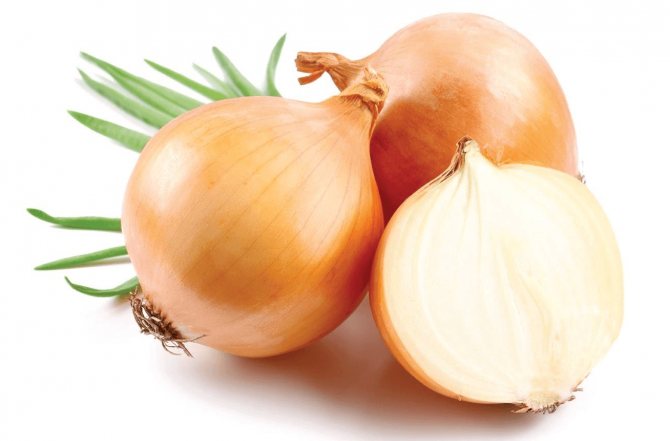

Yellow onions
Onions can be of different pungency, distinguishing between sweet, semi-sharp and spicy. Spicy onions are best preserved, they have the toughest husks. The easier it is to peel the onion, the softer the husk, the sweeter the onion.
Onions keep well under two temperature conditions:
- warm 18-22 degrees, humidity 50-70%;
- cold -1 ... 0 degrees - for sweet and semi-sharp onions, -3 ... -1 - for hot onions, humidity - 75-90%.
A warm regime can be created at home, but it is better not in the kitchen, where the air temperature often rises above 22 degrees and frequent changes in humidity are possible.
Cold mode can be created on the balcony, cellar, underground, garage.
When storing on the balcony, the box with onions must be insulated, for example, with a blanket, so as not to freeze in winter in extreme cold.
When stored properly, onions can last up to 240 days in good condition.
White onion
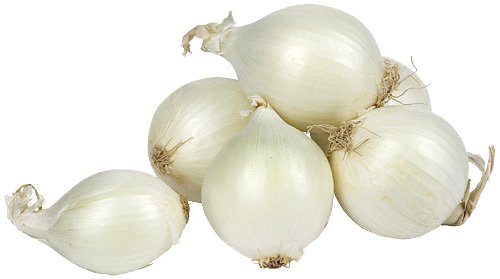

White onion
White onions are the sweetest of all onions. It is stored less than others, and is more likely to rot. The storage area must be well ventilated and dry. Storage temperature 18-22 degrees and humidity 50-70%. However, even observing the above rules will not give a long-term good result. White onions are not bought for storage, it is better to cook them right away. Due to its short shelf life, white onions are not very popular among gardeners.
Red onion, including Crimean (Yalta)
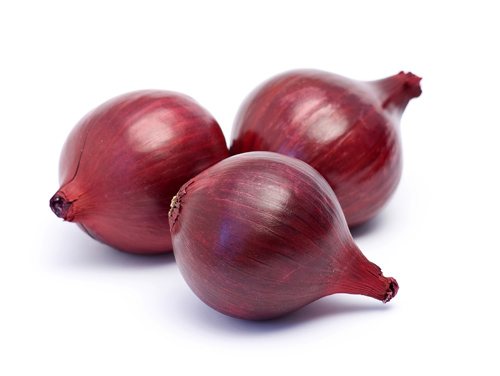

Red onion
Red onions, like white onions, are sweet onions that, unfortunately, are not stored for long. Maximum - 120 days. The preferred storage method is at home. If possible, it is better to store such onions in bundles, Yalta (Crimean) onions are most often sold this way. And the advice from the sellers is always the same: you need to store the Crimean onions in a bundle, in a dry, ventilated room.


Bundles of Crimean onions
Leek
Fresh leeks can be stored for up to 6 months. It perfectly tolerates frosts down to -7 degrees.
Storage in boxes on the balcony and in the cellar


Leeks are kept in boxes
They store it together with the leaves, cut the roots a little without touching the bottom. Storage is organized in a large sand box. The sand is disinfected in advance, that is, calcined.
Spread sand 5–7 cm thick on the bottom of the box, place the leeks vertically in it, cover the spaces between the heads with wet sand. Store in cellars at a temperature of 0 ... + 4 degrees and a humidity of 80–85%. You can store the boxes on the balcony, but in this case, cover the onions with a warm blanket to avoid too low a temperature.
Cold storage
When storing leeks in the refrigerator, you need to cut the roots off. Pack the washed and dried leeks in plastic bags and put them in the refrigerator, in a compartment where the temperature is maintained at +5 degrees and above.
If the leek is finely chopped and placed in a bag, then it can be stored in the freezer for a long time.
Video: how to store leeks
Green onions


Green onions are stored in the refrigerator
Green onions can be stored in different states, it all depends on what you want to use them for in the future.
Cold storage
If you need onions for your salad, you need to keep them fresh.
Fresh onion feathers can be stored in the refrigerator for up to one and a half months at a temperature of + 1 ... + 8 degrees. Feathers must be strong and intact. Onions are pre-washed and dried. Then they are placed in bags or in glass containers.
- Plastic or vacuum bag. By storing onions in bags that are placed in the refrigerator in advance for 15 minutes. Next, fresh dry onion leaves are placed in these bags and put into the refrigerator. During storage, the onions are sorted every two weeks in order to select rotting feathers. Onions in this way can be stored for up to a month and a half.
- Glass jar. The storage method is suitable only for short onion feathers completely without kink fit in a jar. The washed and dry fresh feathers are put in a jar, covered with a lid and stored in the refrigerator for up to a month.
Chopped green onions can still be put in a glass jar and covered with vegetable oil, so that it covers all the feathers. Store a jar of onions in oil in the refrigerator for up to 6 months. Onions in oil are ready to eat after 3 days.
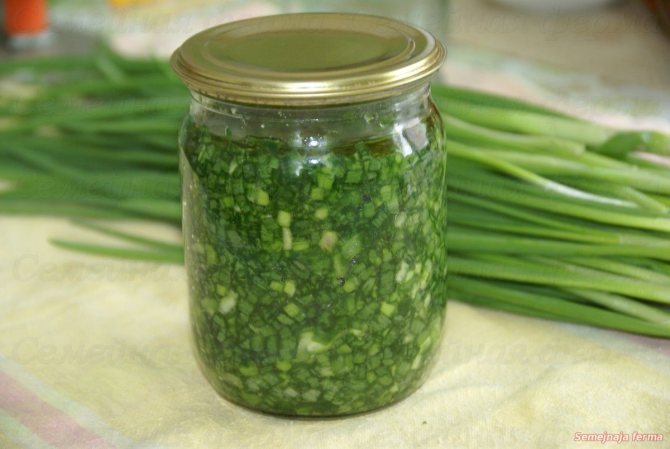

Chopped green onions in oil
Freezer storage


Store chopped green onions in the freezer
If you are going to use green onions in the preparation of main courses and soup, then you can chop them and put them in the freezer.To prevent the onion mass from freezing into one lump, the feathers are pre-cut, placed in a bag in a thin layer and put into the freezer. After the frozen onions can be poured into a common bag. This will keep the onion crumbly. Green onions are stored in the freezer for up to one year at a temperature of -8 degrees.
You can put shredded onions in the freezer in a plastic bottle.
Video: storing green onions in the freezer
Also, green onions can be dried and stored in canvas bags, glass or plastic containers at room temperature for up to two years.
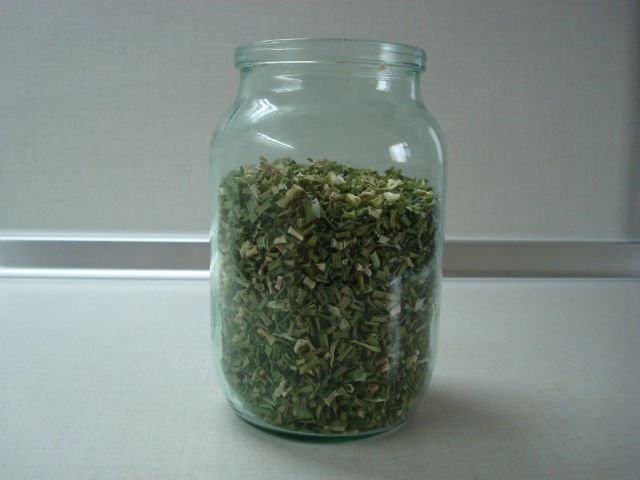

Dried onions can be stored in a glass jar for up to two years.
Peeled and chopped onions
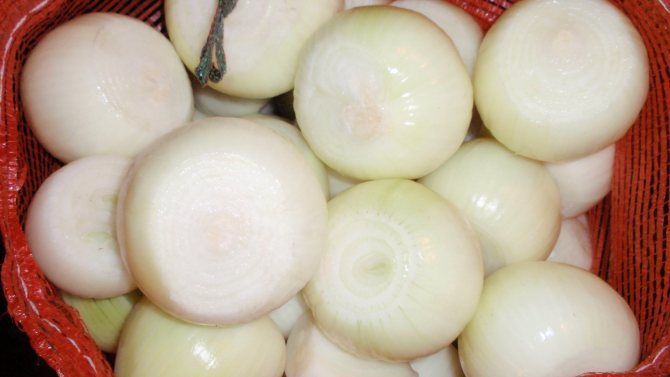

Peeled onions can be stored in the refrigerator.
Often during cooking, it turns out that there are already plenty of onions, and a whole extra onion has been peeled or chopped. In such cases, the product will help preserve the refrigerator.
If you have a whole peeled onion or half left, you can use the following effective ways to preserve it.
- Salt. Pour salt into the container, cut the onion and put it cut side down, put the container in the refrigerator. In this form, the bulb will last from 5 to 8 days.
- Vegetable oil. Lubricate the cut onion with oil, place in a container and refrigerate. The bulb will not go bad within a week.
- Water. If the peeled onion is placed in water and refrigerated, it can last up to two weeks, provided that the water changes every day.
- Food wrap. Wrap the peeled vegetable in plastic wrap and it will be fresh for another 4-5 days.
- The chopped onion can be saved in freezer. You need to store chopped onions in bags in layers no thicker than 5 cm.In this form, it will serve you up to one year.
If chopped onions are dried in the oven or in an electric dryer and put in a dry place in canvas bags or plastic containers, then they will serve you for about two years as a delicious seasoning.
Pickled
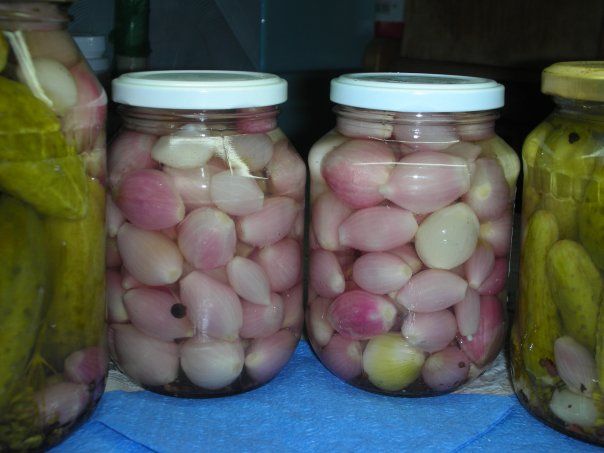

Pickled onions are stored in a cool, dark place.
Any onions and green onions can be pickled. In the marinade, the main ingredient is table vinegar or apple cider vinegar. You can pickle whole onions, or you can already chop them.
In the marinade, green onions are stored in the refrigerator for up to a month.
Pickled onions are best stored in a cool, dark place. Unopened cans of pickled onions stand quietly for six months.
Basement storage recommendations
Experienced gardeners know that the best place for long-term storage of crops is in the basement. To keep the harvest happy for as long as possible, prepare wooden boxes in advance. Boards must be dry, free of mold and insects. Also, a certain distance must be left between the boards for air circulation.
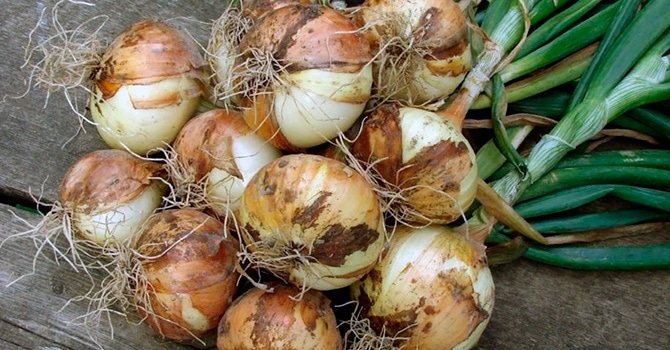

Onions can be put into boxes in layers, but no more than 30 centimeters in height.
If the floor in your basement is earthen, then the boxes should be placed on boards or special pallets, and not directly on the ground, so that the crop does not absorb excess moisture.
If you don't want to use boxes or boxes, you can hang the bow from the ceiling: onion braids or small bags are ideal for this.
Storage temperature of garlic. How to keep garlic until spring: as if only from the garden
To preserve the harvest of garlic for a long time, it is necessary to observe three main parameters: humidity, temperature and light.
An overdried or waterlogged vegetable will quickly deteriorate. You can store garlic at home in an apartment on the balcony or in the refrigerator, in a private house in the cellar.
winter (winter) and spring (summer). Varieties differ in planting time and ripen at different times. The characteristics of the ripeness of the crop, their readiness for harvesting in both species practically do not differ.
The first sign is a change in the color of the leaves, which begin to turn yellow. Literally a couple of days after a complete change in color, the leaves wither and sink to the ground. At this time, you should start harvesting.
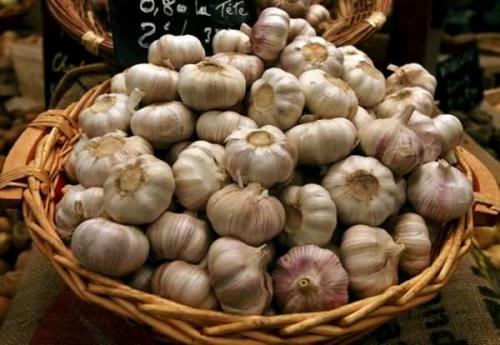

Winter garlic varieties have a distinctive feature - airy bulbs, which begin to overripe and burst in a thin skin.
When picking, the heads of garlic should literally disintegrate into the palm of your hand and have a completely dry, firm structure. For storage, drying, preparation of blanks, fruits without an elastic top layer are categorically unsuitable.
The husk is white, sometimes slightly grayish, traditionally with purple veins. When harvesting, care must be taken to ensure that there is no damage to the skin of the bulbs.
Scratched, dented cloves should be eaten immediately, or thrown away, they cannot be stored for a long time. Do not use shovels or large garden tools for cleaning. The crop should be carefully dug out by hand.
Storage problems
Garlic is fairly easy to store without spoiling at the right temperature.
Places with normal or low humidity are often used. For storage, it is preferable to choose warm rooms, devoid of light or with low light.
After harvesting, first of all, it is necessary to thoroughly clean and dry the crop. The heads of garlic should be washed with clean water, wiping off the soil and dirt with light movements. After the crop should be dried clean.
It is better to shake off the dirt harder, removing the top layer of husk. The method is ideal for storing completely peeled cloves. Before drying the bulbs, you must cut off the lower antennae, roots.


Be sure to read:
How to store beans at home?
Storage temperature of garlic
Garlic is especially picky about the cold; along with other vegetables, it will not tolerate a strong drop in temperature.
The most favorable indicator will be the range from +10 to +15 ° С. A tolerable temperature regime will be the interval from +3 to +10 ° С.
In an excessively warm place, the cloves will quickly begin to dry out, becoming unsuitable even for cooking.
Storage moisture for garlic
Garlic is very sensitive to moisture, and it is highly discouraged to store it in poorly ventilated parts of the house. Condensation will have a disastrous effect on the safety of the crop.
Therefore, it cannot be put into plastic bags, plastic containers, buckets for a long time. You should store crops in the cellar, basement for the winter using wooden boxes, boxes or baskets.
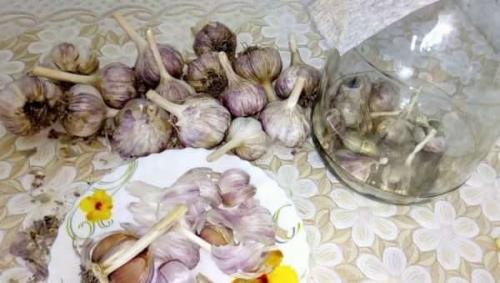

If you plan to store a large amount of garlic harvest, then boxes with low sides will be the best option. In them, the bulbs are laid out in a thin layer, which will allow the boxes to be ventilated.
Canvas, cloth bags are hung from the ceiling of the utility room for drying and efficient ventilation of the crop.
Regardless of the method chosen, sawdust, hay, soft husks or ash should be poured between layers on top of the bulbs. The dry composition will absorb moisture if it gets into the storage.
The layer will help protect vegetables from winter frost. As a result, the harvest will last much longer.
How to store garlic at home in winter?
Before tying the stems into bunches and sending them to be stored in boxes, it is imperative to thoroughly dry the vegetable. This procedure takes a couple of days, but it is better to leave the garlic to dry for at least a week.


The bunches together with the leaves are suspended on ropes, there should be enough distance between the stems for ventilation. It is advisable to select a dry place with a light, warm wind.
Storage in bundles
The stems are cut almost completely, it is necessary to leave 5-12 cm. They are tied with a rope or thick thread, forming bunches that are easily suspended from nails or rope.
It is advisable to leave the bundles to dry over the stove, battery in any warm, dry place. After a week, they should be removed and put into the cellar.Bunches of bulbs can be left hanging in the apartment in the kitchen for months.
Taking into account the winter cold snap, the apartment will have a quite comfortable temperature for long-term storage of vegetables. Favorable storage will take place in dark, light-free places.


Be sure to read:
How to store tomatoes - keeping fresh fruits until winter 9 ways
Storage in braids
The method of storing garlic in braids is not very different from that described above, you will need to leave a rather long stem, almost not cutting off at all.
Braids from the stems are woven in the same way as when weaving braids from hair. The braid is additionally secured with a rope and suspended for further storage.
Recommendations for storage in the apartment
If the humidity in your apartment is not very high (around 60%), and it is possible to maintain a constant temperature, then the crop can be stored at home. For these purposes, a glazed balcony or loggia is best suited.
Pre-drilled cardboard boxes or small wicker baskets are great for home storage.
I also advise you to watch a video showing how to store this vegetable.
Varieties of onions
There are many types of onions, and they are all delicious and healthy. I'll show you how to store the most popular ones.
Green onions
Young green onions are ideal for salads, soups, and sprinkles for main courses. But it should be fresh and juicy. To do this, I recommend that you wrap it first with a cloth soaked in water, then with paper and put it in the compartment of the refrigerator designed for storing fruits and vegetables. This simple method will allow you to keep your greens fresh for 10 days.
If you plan to use the cut green shoots almost immediately, you can put them in a small jar of water to prevent them from losing moisture.
Leek
It is believed that leeks can be stored for a long time without losing their taste. To do this, put some sand on the bottom of the wooden box - about 5 centimeters, then put one layer of onion, sprinkle it with sand again, and so on. From above, the entire crop must also be covered with sand.
If everything is done correctly, then the leek can retain its properties and taste for about six months at a temperature of about 0 and at a humidity of 80%.
Sevok
Many summer residents prefer to independently take care of what they will plant in the beds in the spring. Therefore, many store onions not only for food, but also as material for subsequent planting.
The sowing bulbs are small and must be kept at a temperature of at least 15 degrees.
Red (Yalta) grade
The red onion variety is renowned for its sweet, more delicate flavor. Unfortunately, this type of plant is less suitable for long-term storage than its golden gathers. It is best to keep it in braids. In this case, the shelf life does not exceed 4-5 months.
Green onion feathers
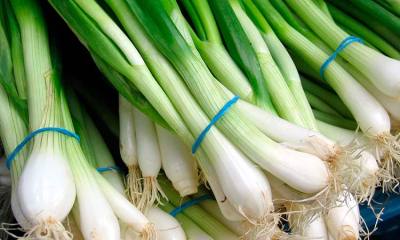

The main condition for long-term storage of juicy and healthy green onions is the correct temperature regime.
So, at a temperature of 0 ° C, green onion feathers retain their juiciness for two months. At + 3-4 ° C, greens can be stored for no more than twenty days..
At room temperature (+ 18-20 ° C), green onion feathers will wither after three days. You can store chopped green onions in the freezer (-18 ° C) for up to twelve months.
Drying finely chopped green onions in the oven (+ 50-60 ° C) will help preserve the healthy product for at least two years.
Only whole, juicy, bright green feathers are left for storage Luke. Dry, wilted stems are discarded immediately. Feathers with damage and signs of deterioration should be removed and used as soon as possible.
Read about how to store green onions in the refrigerator here, for the winter - here.
Pickled onion
If desired, onions can be pickled.Thus, you will not only save it, but also get a ready-made appetizer or addition to salad or kebab.
Select small onions, or simply cut large ones into halves or quarters.
You will need:
- onions - 1 kg;
- olive oil - 500 ml;
- table vinegar - 500 ml;
- salt - 1 tablespoon;
- sugar - 50 grams;
- bay leaf - 1-2 pieces;
- black pepper - a few grains;
- dill.
Cover small onion in husk with water and bring to a boil. Once the water boils, transfer it to a colander and place under cold water.
Peel the bulbs and leave in cold water.
To make the marinade, combine the vinegar, salt, sugar, bay leaf and pepper in a saucepan and bring to a boil. Add oil and onions to the marinade. Reduce heat to low, cover and let it brew for 10-15 minutes.
Then remove from heat, distribute over clean jars, adding a little dill to them. Close the lids tightly.

